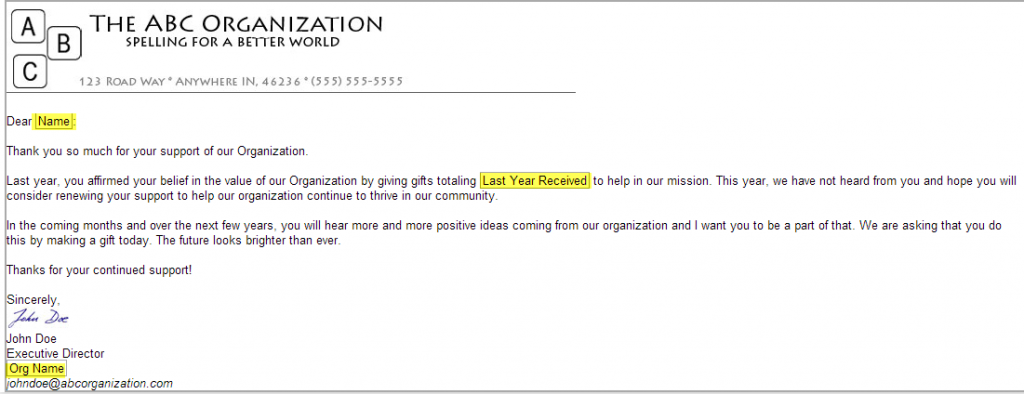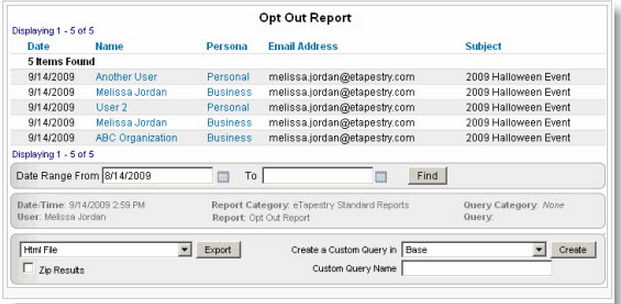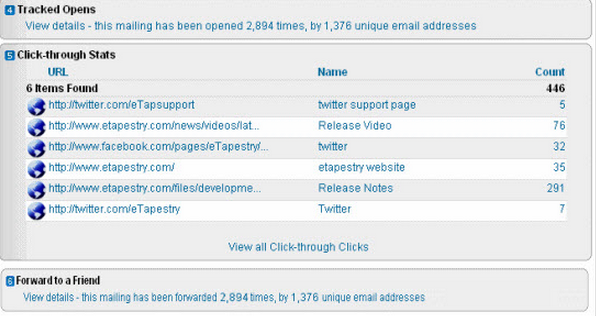Email Marketing with eTapestry
The Role of Email Marketing
The first thing to remember about email marketing is that it is all about trust. Unlike social media, this is a private channel of communication where your constituents are signing up to receive information from you. It is crucial to build and maintain this trust by delivering the right content, to the right people, at the right time. There are really five questions you should ask yourself before setting up an email marketing campaign:
- What are you trying to do?
- Who are you trying to target?
- What message will help you get there?
- How will you deliver your message?
- Did it work?
Question #1: What are you trying to do?
The answer to this question will guide your answer to every other question. Before you start thinking about anything else, you have to be clear on what it is you are trying to accomplish. What are your goals? Do you want to increase exposure? Build relationships? Obtain donations? Drive attendance? Whatever you decide, it is important you take it one goal at a time. Make sure the goal you choose for each email campaign is one that aligns with your mission, and that it is in strong alliance with the goals of other key department leaders.
Question #2: Who are you trying to reach?
So you know what you want to do, now what? Now you decide who it is you want to be talking to. Who is your target audience? This could be current donors, volunteers or alumni, future prospects who could become donors, or lapsed donors you haven’t heard from in a while. When you decide who it is that you are targeting, it will become easy to connect that audience with the goal you are trying to achieve. It’s also crucial that you understand your audience. Take an inventory through queries in eTapestry to identify what you know about the group, and how that could play into the message you send them. Some fields that are great to query off of in eTapestry for segmentation are: geography, amount last donated, and the number of years they’ve been a supporter.

Data Merge Fields in eTapestry allow emails to appear personalized. Use any field you want including: the last Fund they donated to, city they live in, program of interest, etc. You can even pull and input the next payment amount with due date.
Question #3: What message will help you get there?
Once you understand your audience, give them what they want! There are three main types of emails: Informational, Relational, & Promotional.
Informational emails (newsletters, facts and tops, updates) are most appropriate if your goal is to increase exposure. They are a great way to deliver knowledge, establish trust and credibility, or widen audience readership through forwards, shares and referrals. In eTapestry, there are many correspondence templates to choose from so you can create mailings and easily send professional looking communications.
Relational emails (thank you emails, holiday greetings, acknowledgements) help you to build relationships and should focus content on experience and announcements to gain retention and loyalty. Bonus: these can also be automated in eTapestry so when a supporter gives online, they automatically receive a thank you!
Promotional emails (solicitations, annual appeals, event invitations) are your money-maker communications—great for obtaining donations or driving attendance to a fundraising event. Focus content here on the call to action, and don’t be afraid to be direct!
Question #4: How will you deliver your message?
In the world of email marketing, timing is everything. When we talk about timing we are talking about two important components—frequency and delivery. Frequency refers to how often you send emails, and can be managed via a master calendar. You can even use the calendars in eTapestry to ensure you are keeping track of all of the email communications your organization sends. Delivery refers to the time you send the message, which should be based on when you know your audience is most likely to read it. Don’t know your supporters’ reading habits? No problem! You can test for timing in eTapestry by splitting up your segmented list into three parts, sending the same email at different times and days, and comparing results.
Question #5: Did it work?
When evaluating the success of your email marketing campaign, there are a few key metrics that really matter:
- Open Rate shows the effectiveness of your subject line, and overall interest in the topic of your email.
View Tracked Opens in eTapestry to identify how many times, and by how many recipients, your email was opened. You can then drill into that link to view a report of those email addresses and the time they opened the email.
- Click-Through Rate shows how your message resonated with your audience. It is a great metric to use for new audience segments that you don’t know a lot about yet.
Use the Click-Through Stats report to show many times each of the links in your email have been clicked. You can also “view all click-through clicks” to view a report of all recipients who clicked on those links, and the time they clicked them. You can then save a query of these email addresses who share similar interests to use in future campaigns!
- Social Shares tracks supporter engagement by giving you insight into how social media sites are helping to get the word out about your various fundraising strategies.

The Shared Links Report in eTapestry allows you to see which of your emails have been shared on which social media outlets, and how many times those shared links were clicked on each social media outlet.
- Opt Outs let you know when to call it quits.

Use the Opt Out Report to view the email addresses that have opted out of receiving emails from your organization. You can then create a Custom Account Query of the accounts to be used in mass updates. Warning: You should only remove the opt out designation on a constituent's persona if they have expressly asked you to do so, or you may be in violation of the federal CAN-SPAM act.
Email marketing is a powerful communication method that can take your level of fundraising to the next level. By utilizing these metrics in eTapestry, you will be able to make better decisions to drive your content strategy and ensure you are targeting the right audience!
Want to learn more about Advanced Mass Email in eTapestry? Contact your client relationship manager to make sure you are fully utilizing these powerful email marketing best practices!


Leave a Comment